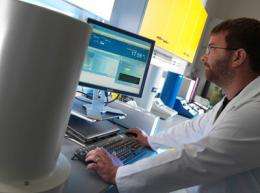Traceability for cancer therapy

Scientists from the National Physical Laboratory (NPL) have worked to establish traceability for a molecular radiotherapy treatment for patients suffering from neuroendocrine tumours.
Neuroendocrine tumours are usually found in the intestine or lungs and arise from hormone-producing cells. A new treatment involves the administration of a peptide, radiolabelled with the beta- and gamma-emitting radionuclide Lutetium-177 (177Lu), which irradiates the widespread tumour cells without causing excessive damage to surrounding healthy tissue. The treatment can also be followed by nuclear imaging, taking advantage of the gamma-emission of the radionuclide.
Following a series of clinical trials, this radiopharmaceutical is now beginning to be used routinely for molecular radionuclide therapy (MRT) throughout the UK and Europe.
A team of NPL scientists first established a link to the International Reference System by standardising 177Lu as part of an international comparison in 2011. Once that had been established, NPL invited UK and European hospitals that regularly use this radionuclide to participate in a blind exercise to measure the radioactivity in samples of 177Lu. From the results of this exercise, the hospitals could demonstrate traceability, ensuring regulatory compliance and patient safety. The results showed that the majority of participants have the capability to measure the 177Lu activity to within 2%, with only three participants showing variations higher than this.
The same team of scientists is now working on the next important step towards establishing traceability for 177Lu imaging, within the framework of a European Metrology Research Programme (EMRP) project called 'Metrology for Molecular Radiotherapy'.














